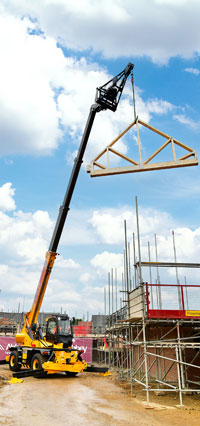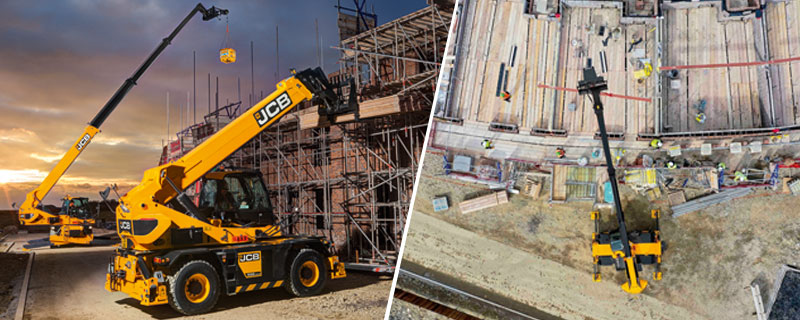JCB Chief Innovation and Growth Officer Tim Burnhope highlights how equipment manufacturers are meeting the needs of housebuilders with innovative equipment, purpose built for modern methods of construction, as the industry strives to tackle the housing crisis.
As housebuilding historians will know, the concept of off-site construction came to prominence in the UK in the aftermath of World War 2 when Winston Churchill promoted prefabricated housing as a rapid solution to the housing crisis brought about by the conflict.
In the subsequent years, we have been slower to adopt the method than our European neighbours, staying largely loyal to traditional methods – but that is undoubtedly changing. The cause? Another housing crisis, this time brought about by a perfect storm of economic and demographic conditions.
Demand Exceeds Supply
To meet the changing needs of a growing population, the Government has a target to deliver 300,000 new homes every year by the mid-2020s. Unfortunately, it is a target that has never been reached to date. Not only is there a supply and demand imbalance, but it is also getting worse each year while ownership remains well beyond reach for many people. The need to build more homes – rapidly, affordably and sustainably – is greater than ever. Yet housebuilders face significant challenges, not least a materials shortage, increasing material costs and scarcity of skilled labour.
Modern methods of construction (MMC) can help to address these challenges with a quicker and lower cost solution thanks to reduced time onsite and fewer defects to rectify. As a result, even in a UK market typically resistant to change, the adoption of MMC is gathering momentum. Globally the modular and prefabricated housing market is expected to grow from $17 billion in 2020 to $28 billion in 2025. This time the UK is set to follow. For example, Barratt Developments PLC has already stated its intention to increase modern methods of construction to 30% of its housing completions by 2025.
Tailor Made Solution
 This evolution towards modular construction is welcomed, but it presents challenges to the equipment sector too. For us, it is not just a case of how many homes will be built, but a question of how they will be built too. The likely change towards manufacturing off-site requires different tools and skills to assemble buildings when on-site – with heavier lift capacities and additional versatility necessary.
This evolution towards modular construction is welcomed, but it presents challenges to the equipment sector too. For us, it is not just a case of how many homes will be built, but a question of how they will be built too. The likely change towards manufacturing off-site requires different tools and skills to assemble buildings when on-site – with heavier lift capacities and additional versatility necessary.
The rotating telescopic handler is now widely recognised as a must-have machine on modern construction projects with its total versatility, offering the use of pallet fork and a variety of jib and winch arrangements for suspended loads. With MMC and modular housebuilding becoming more mainstream, we concluded that rotating telescopic handlers were must-have additions to JCB machine range.
It is against this backdrop that JCB – already the world’s number one telescopic handler manufacturer – entered the market for rotating telehandlers in 2019. Initially we launched the 21-metre 555-210R model and more recently, last year, we introduced a second, 26-metre variant; the 555-260R. Two machines purpose-built for the modern construction site with the hallmarks of simplicity, safety, efficiency, versatility, and productivity.
The two JCB models have been designed to meet and exceed the changing requirements of contractors and rental companies across the world – offering a genuine cost-effective versatile replacement for smaller fixed and mobile cranes, with rapid set-up, ease of use and the ability to carry out a wide range of technical lifting operations.
They truly offer a three-machines-in-one solution – capable of traditional telehandler, mobile crane and man platform applications. As such, they are perfect for a raft of typical tasks including lifting triangular roof trusses, placing and piecing together modular panels, steel erecting, handling glass and cladding, while at the same time performing safe and accurate MEWP operations.
High Spec Versatility
Powered by JCB’s proven Dieselmax engines, the rotating telescopic handler range shares a high degree of parts commonality with JCB’s world leading rigid chassis Loadall telehandler models. Powered by an EU Stage V emissions engine, it features Auto Engine Idle and Auto Engine Stop to further reduce fuel use and exhaust emissions.
The 555-210R & 555-260R have a lower chassis mounted engine layout, providing easy, safe access for ground-level servicing. With 500-hour intervals and a best-in-class SAE serviceability rating, the machines deliver maximum uptime and enhanced productivity.
Key features of the machines include:
Simplicity, ease of use and familiarity with JCB Loadall range
5.5-tonne maximum lift capacity
20.5 and 25.5m maximum working heights
Industry-leading automated set-up times
All-round visibility and access, improving site safety
Winches and aerial work platforms among a growing range of options
Customer Attraction
It is this combination of qualities that has led one of the UK’s leading equipment rental firms to invest more than £5 million in a fleet of the JCB models – the biggest order so far for the new product.
Nationwide plant hirer Charles Wilson Engineers (CW Plant) has ordered 25 machines including the 21-metre 555-210R machine and 26-metre 555-260R models. Supplied by dealer Greenshields JCB, the new machines are operating for CW Plant’s customers across the UK including Abbey Developments Ltd on its new build site in Stoke Mandeville.
Director, Graham Pollard said: “Charles Wilson Engineers is committed to owning the best fleet of equipment in the industry. We chose JCB for their renowned product quality and service back up. The rotating telehandler market is a growing one and we want to be at the forefront of that by building the number one fleet in the UK.”
Powerful performance
Both machines have a maximum lift capacity of 5.5 tonnes and highly competitive load charts. The twin hydraulic lift ram design offers unrivalled hydraulic lifting performance. Auto one-touch deployment, stowage and levelling of outriggers ensures ease of use and minimal set-up time, while competitive lift-end cycle times with high-flow auxiliary hydraulics ensure efficient winch work, further boosting productivity.
The low-mounted, clean boom design, helps to deliver excellent all-round operator visibility, boosted by a comprehensive package of working light and camera kit options, including a boom-head camera for precise load placement at height. The cab maintains JCB’s familiar feel, with a simple to operate, industry-standard control layout and a variety of comfortable seating options, ensuring all-day working comfort.
All JCB rotating telescopic handlers can be used with a wide range of attachments. This includes pallet forks, a 5.5-tonne carriage winch, a 2-tonne x 2m jib winch, a reduced height jib, a 5.5-tonne hook, light duty shovel, 360° rotating forks and a range of useful fork-mounted accessories. The machine also offers remote-control lift-end operation and the availability of aerial access platforms. In addition, the range of specially developed JCB attachments utilise auto recognition (RFID tag) technology, whereby attachments are identified by the machine, automatically selecting the correct load chart for the application and keeping you in a safe working envelope.
The Perfect Partner
As well as the machines themselves, JCB customers benefit from an unrivalled package and support. In addition to a nationwide dealer network and rapid parts supply, each machine is also fitted with JCB LiveLink as standard. JCB LiveLink gathers data from sensors and generates pre-emptive servicing and potential fault alerts. These are continually monitored at JCB’s Uptime Centre to optimise machine performance and availability for work. JCB LiveLink can also be used for security by setting up alerts if the machine is used outside user-defined curfew periods and geo fences. This combination means total peace of mind for customers as they focus on their own critical role as we all pull together to address the housing shortage.






Leave a Reply
Want to join the discussion?Feel free to contribute!